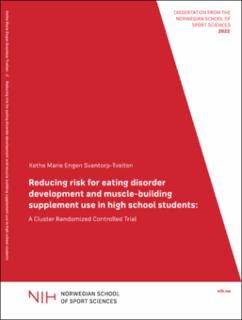| dc.contributor.author | Svantorp-Tveiten, Kethe Marie Engen | |
| dc.date.accessioned | 2022-05-03T09:01:43Z | |
| dc.date.available | 2022-05-03T09:01:43Z | |
| dc.date.issued | 2022 | |
| dc.identifier.isbn | 978-82-502-0602-1 | |
| dc.identifier.uri | https://hdl.handle.net/11250/2993808 | |
| dc.description | Avhandling (doktorgrad) - Norges idrettshøgskole, 2022 | en_US |
| dc.description.abstract | Background: The global burden of eating disorders (EDs) is increasing and is highest in Western countries. Development and implementation of interventions successful in promoting mental health and preventing EDs in adolescents have been requested by researchers, professionals, and stakeholders for several years. However, among the few intervention studies using a randomized and controlled design, most are hampered by having a small sample size, a short follow-up period, and a lack of measures assessing muscularoriented body image and disordered eating (DE). Inclusion of such measures has been suggested as important, especially for boys. There is limited knowledge about the use of muscle-building supplements and ED risk factors in adolescent boys and girls. Increased knowledge about the association between muscle-building supplement use and ED risk factors is needed to clarify whether prevention of muscle-building supplement use can be included within an ED prevention intervention. Additionally, knowledge about change mechanisms is important to understand which psychological factors are important to target within an intervention to facilitate a risk reduction or preventive effect. Such insight may be beneficial when developing or refining intervention programs in the future. Unfortunately, few studies have investigated mediators in universal ED prevention programs. The Healthy Body Image (HBI) intervention was developed to fill current research gaps and respond to methodological limitations from previous research.
Objectives: In the first paper, we aimed to identify adolescents’ use of muscle-building supplements and explore whether such use was independently explained by ED risk factors, exercise, sport participation, and immigrant status in boys and girls. In the second paper, we investigated the immediate and 12-month effects of the HBI intervention on risk and protective factors for ED development and muscle-building supplement use in high school boys and girls. In Paper III, we explored potential mediators for the HBI intervention’s effect on ED symptomatology and muscle-building supplement use in girls and boys. Methods: The HBI intervention is a cluster-randomized controlled trial including 30 high schools in Oslo and Akershus counties. In total, 2,466 12th-grade students (43% boys) were included in the study and randomly allocated to the HBI intervention or control group (classes as usual). The HBI intervention was comprised of three workshops targeting 1) body image, 2) (social) media literacy, and 3) lifestyle. Students were assessed at the baseline, posttest, and 3 and 12 months after the intervention. A Mann-Whitney U test and a chisquared test were performed to determine whether muscle-building supplement use differed between participants of different genders or immigrant status while multiple hierarchical regression analyses were performed to examine the baseline muscle-building supplement use and the association with ED risk factors, exercise, sport participation, and immigrant status. Furthermore, a mixed linear model was used to examine the effect of the intervention at all assessment points while conditional growth curve analyses were applied to investigate the indirect effects of the intervention on ED symptomatology and muscle-building supplement use.
Results: Paper I found that the use of muscle-building supplement use is more common among boys than among girls and is more common among immigrants than nonimmigrants. The use of muscle-building supplements was associated with ED risk factors and exercise and sport participation in boys but not in girls. Paper II revealed that the intervention had a lasting effect on all outcomes. Gender was a significant moderator in several outcomes, where girls benefited more in terms of psychological outcomes and only boys reduced their use of muscle-building supplements. Paper III revealed several indirect effects of the intervention in girls with respect to ED symptomatology. No indirect effects were observed in boys.
Conclusion: Prevention of muscle-building supplements is warranted, especially among boys. Moreover, the HBI intervention produced sustained effect in reducing risk and enhancing protective factors for ED development in boys and girls and prevented the use of muscle-building supplements in boys. However, girls tended to benefit more from the intervention than boys did. The study provides several potential mechanisms of change for ED symptomatology in girls. Several adjustments and modifications should be made to enhance the effect in boys such as including a male intervention deliverer, focusing more on creating a safe place for sharing, using digital intervention methods, and possibly expanding the intervention outside the classroom setting. | en_US |
| dc.language.iso | eng | en_US |
| dc.relation.haspart | Paper I: Svantorp-Tveiten KME, Friborg O, Torstveit MK, Mathisen TF, Sundgot-Borgen C, Rosenvinge JH, Bratland-Sanda S, Pettersen G, Sundgot-Borgen J. Protein, creatine and dieting supplements among adolescents: Use and associations with eating disorder risk factors, exercise- and sports participation, and immigrant status. Front Sports Act Living 2021;3(727372.):1-11. | |
| dc.relation.haspart | Paper II: Svantorp-Tveiten KME, Torstveit MK, Rosenvinge JH, Sundgot-Borgen C, Friborg O, Bratland-Sanda S, Pettersen G, Sundgot-Borgen J. Effect of A Healthy Body Image intervention on risk- and protective factors for eating disorders: A cluster randomized controlled trial. Ment Health Prev. 2021:200225. | |
| dc.relation.haspart | Paper III: Svantorp-Tveiten KME, Ivarsson A, Torstveit MK, Sundgot-Borgen C, Mathisen TF, Bratland-Sanda S, Rosenvinge JH, Friborg O, Pettersen G, Sundgot-Borgen J. The Healthy Body Image (HBI) intervention and reduction in eating disorder symptomatology and supplement use in high school students: a study of mediating factors. Front Psychol. 2022; [in review]. | |
| dc.subject | nih | en_US |
| dc.subject | doktoravhandlinger | en_US |
| dc.title | Reducing risk for eating disorder development and muscle-building supplement use in high school students: A Cluster Randomized Controlled Trial | en_US |
| dc.type | Doctoral thesis | en_US |
| dc.description.version | publishedVersion | en_US |
| dc.description.localcode | Institutt for idrettsmedisinske fag / Department of Sports Medicine | en_US |
